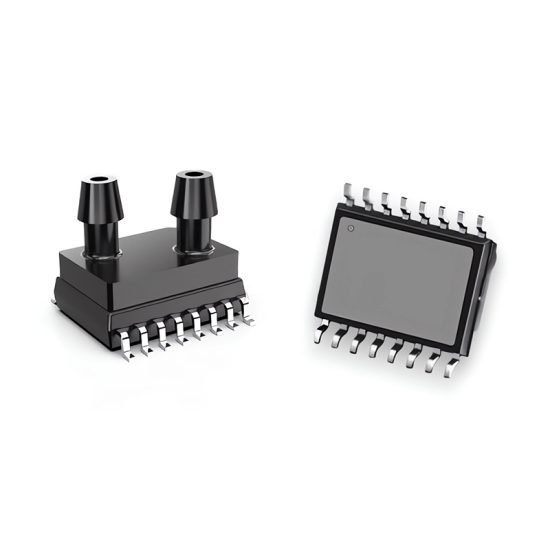Katalog
Modern high-rise fire systems depend on accurate pressure monitoring to ensure safe operation. Differential pressure sensors serve as core detection elements, enabling precise measurement of fire hydrant water pressure, network pressure, and ventilation system air pressure.
1. Technical Principles of Differential Pressure Sensors in Fire Systems
1.1 MEMS Technology Foundation
MEMS differential pressure sensors use microelectromechanical systems technology, integrating mechanical structures with electronic circuits on a single chip. The sensor’s internal silicon diaphragm undergoes micro-deformation under pressure, converting to electrical signals through piezoresistive effects. This design ensures high-precision measurement and long-term stability.
1.2 Signal Processing and Output
The sensor’s integrated high-precision amplification circuit amplifies and conditions weak signals. Zero and full-scale compensation ensure linearity within the measurement range. Output signals can be customized according to application requirements, including analog voltage, current, or digital interfaces.
2. Building Fire Monitoring Applications
2.1 Fire Hydrant Water Pressure Monitoring
Differential pressure sensors enable intelligent remote monitoring of fire hydrants, continuously monitoring water pressure conditions. When a hydrant’s water pressure falls below preset thresholds, the system immediately alerts maintenance personnel for timely response. This proactive monitoring eliminates traditional manual inspection blind spots.
2.2 Fire Network Pressure Monitoring
Building fire networks cover wide areas with numerous pressure monitoring points. Differential pressure sensor networks can monitor pipeline pressures in real-time, promptly detecting leaks or blockages. Through data analysis, systems can assess network operational status and predict potential failures.
2.3 Positive Pressure Supply System Monitoring
High-rise building positive pressure supply systems require precise pressure control. Differential pressure sensors monitor pressure differences in stairwells and anterooms, ensuring effective smoke spread prevention during fires. Sensors can monitor positive, negative, and differential pressures in real-time.
3. Technical Performance Advantages
3.1 High Precision and Stability
MEMS differential pressure sensors possess excellent measurement accuracy and long-term stability. Advanced manufacturing processes and materials ensure stable performance in harsh environments. Temperature compensation technology eliminates environmental factors’ impact on measurement accuracy.
3.2 Reliability and Durability
Sensor design considers special requirements of fire environments, featuring excellent shock and vibration resistance. Diaphragm isolation technology protects core sensitive elements, extending sensor lifespan. Sealed designs ensure normal operation in humid environments.
4. System Integration and Intelligence
4.1 Multi-sensor Fusion
Modern fire systems adopt fusion solutions of multiple sensor technologies. Differential pressure sensors work collaboratively with temperature-humidity sensors, temperature sensors, and liquid level sensors to build complete fire warning monitoring systems.
4.2 Network Monitoring
Sensor networks connect to central monitoring systems through wired or wireless methods, enabling remote monitoring and data collection. Network monitoring allows maintenance personnel to understand entire building fire system status in real-time.
5. Application Expansion and Development Trends
5.1 Industrial Application Extension
Successful applications of differential pressure sensors in fire protection are expanding to other industrial fields. Petrochemical, environmental protection, and air compression industries have growing demands for precise pressure monitoring.
5.2 Technology Development Direction
Sensor technology is developing toward higher precision, lower power consumption, and stronger intelligence. Integration levels continue improving with increasingly rich functionality. Wireless transmission technology makes sensor deployment more flexible.
Çözüm
Differential pressure sensors play an irreplaceable role in building fire precision detection. Through accurate monitoring of fire hydrant water pressure, network pressure, and ventilation system differential pressure, they provide reliable technical guarantees for fire safety.
Yukarıdaki giriş, basınç sensörü teknolojisi uygulamalarının yalnızca yüzeyini çizmektedir. Çeşitli ürünlerde kullanılan farklı sensör elemanları türlerini, bunların nasıl çalıştığını, avantajlarını ve dezavantajlarını keşfetmeye devam edeceğiz. Burada tartışılanlar hakkında daha fazla ayrıntı istiyorsanız bu kılavuzun ilerleyen bölümlerindeki ilgili içeriğe göz atabilirsiniz. Eğer vaktiniz kısıtlıysa bu kılavuzun detaylarını indirmek için buraya da tıklayabilirsiniz. Hava Basınç Sensörü Ürünü PDF verileri.
Diğer sensör teknolojileri hakkında daha fazla bilgi için lütfen Sensörler sayfamızı ziyaret edin.

